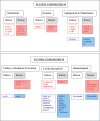The non-human primate model of endometriosis: research and implications for fecundity
- PMID: 19633013
- PMCID: PMC2744471
- DOI: 10.1093/molehr/gap057
The non-human primate model of endometriosis: research and implications for fecundity
Abstract
The development of an animal model of endometriosis is crucial for the investigation of disease pathogenesis and therapeutic intervention. These models will enhance our ability to evaluate the causes for the subfertility associated with disease and provide a first-line validation of treatment modulators. Currently rodents and non-human primate models have been developed, but each model has their limitations. The aim of this manuscript is to summarize the current findings and theories on the development of endometriosis and disease progression and the effectiveness of therapeutic targets using the experimental induced model of endometriosis in the baboon (Papio anubis).
Figures

Similar articles
-
A baboon model for endometriosis: implications for fertility.Reprod Biol Endocrinol. 2006;4 Suppl 1(Suppl 1):S7. doi: 10.1186/1477-7827-4-S1-S7. Reprod Biol Endocrinol. 2006. PMID: 17118171 Free PMC article. Review.
-
Endometriosis research: animal models for the study of a complex disease.J Reprod Immunol. 2010 Nov;86(2):141-7. doi: 10.1016/j.jri.2010.05.001. Epub 2010 Jul 1. J Reprod Immunol. 2010. PMID: 20594597 Review.
-
Altered expression of microRNA-451 in eutopic endometrium of baboons (Papio anubis) with endometriosis.Hum Reprod. 2015 Dec;30(12):2881-91. doi: 10.1093/humrep/dev229. Epub 2015 Sep 14. Hum Reprod. 2015. PMID: 26370665 Free PMC article.
-
Primate model research for endometriosis.Tohoku J Exp Med. 2012 Feb;226(2):95-9. doi: 10.1620/tjem.226.95. Tohoku J Exp Med. 2012. PMID: 22245765 Review.
-
An efficient model of human endometriosis by induced unopposed estrogenicity in baboons.Oncotarget. 2016 Mar 8;7(10):10857-69. doi: 10.18632/oncotarget.7516. Oncotarget. 2016. PMID: 26908459 Free PMC article.
Cited by
-
What We Have Learned from Animal Models to Understand the Etiology and Pathology of Endometrioma-Related Infertility.Biomedicines. 2022 Jun 23;10(7):1483. doi: 10.3390/biomedicines10071483. Biomedicines. 2022. PMID: 35884788 Free PMC article. Review.
-
Changes in eutopic endometrial gene expression during the progression of experimental endometriosis in the baboon, Papio anubis.Biol Reprod. 2013 Feb 21;88(2):44. doi: 10.1095/biolreprod.112.104497. Print 2013 Feb. Biol Reprod. 2013. PMID: 23284138 Free PMC article.
-
Animal Models of Adenomyosis.Semin Reprod Med. 2020 May;38(2-03):168-178. doi: 10.1055/s-0040-1718741. Epub 2020 Oct 26. Semin Reprod Med. 2020. PMID: 33105508 Free PMC article. Review.
-
Uterine Leukocyte Function and Dysfunction: A Hypothesis on the Impact of Endometriosis.Am J Reprod Immunol. 2016 Mar;75(3):411-7. doi: 10.1111/aji.12487. Epub 2016 Jan 19. Am J Reprod Immunol. 2016. PMID: 26782366 Free PMC article. Review.
-
Nonhuman Primates: A Vital Model for Basic and Applied Research on Female Reproduction, Prenatal Development, and Women's Health.ILAR J. 2017 Dec 1;58(2):281-294. doi: 10.1093/ilar/ilx027. ILAR J. 2017. PMID: 28985318 Free PMC article. Review.
References
-
- Abbott JA, Hawe J, Clayton RD, Garry R. The effects and effectiveness of laparoscopic excision of endometriosis: a prospective study with 2–5 year follow-up. Hum Reprod. 2003;18:1922–1927. - PubMed
-
- Absenger Y, Hess-Stumpp H, Kreft B, Kratzschmar J, Haendler B, Schutze N, Regidor PA, Winterhager E. Cyr61, a deregulated gene in endometriosis. Mol Hum Reprod. 2004;10:399–407. - PubMed
-
- Arici A, Seli E, Zeyneloglu HB, Senturk LM, Oral E, Olive DL. Interleukin-8 induces proliferation of endometrial stromal cells: a potential autocrine growth factor. J Clin Endocrinol Metab. 1998;83:1201–1205. - PubMed
-
- Attar E, Tokunaga H, Imir G, Yilmaz MB, Redwine D, Putman M, Gurates B, Attar R, Yaegashi N, Hales DB, et al. Prostaglandin E2 via steroidogenic factor-1 coordinately regulates transcription of steroidogenic genes necessary for estrogen synthesis in endometriosis. J Clin Endocrinol Metab. 2009;94:623–631. - PMC - PubMed
Publication types
MeSH terms
Grants and funding
LinkOut - more resources
Full Text Sources
Medical

